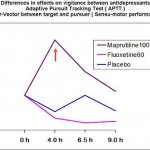Usefulness of the methods
Many drugs interfere with the ability of driving vehicles, piloting or handling dangerous/ complicated machinery by influencing vigilance and CNS performance. Such effects have become an important safety issue in the drug approval process. This concerns drugs which intentionally act on the CNS (e.g. antiepileptics, antidepressants or anxiolytics) and others which may influence vigilance and CNS performance as an undesired effect (e. g. opiates, NSAIDs, antihistamines, myorelaxants etc.). Given that newer representatives of such drug groups are less prone to decrease vigilance and CNS-performance or may even be able to improve these functions (as shown by us for some compounds of the selective serotonin reuptake inhibitor class/ SSRI,  with and without alcohol administration – here an example without alcohol, see figure left), proving this may be of scientific, therapeutic and commercial importance.
with and without alcohol administration – here an example without alcohol, see figure left), proving this may be of scientific, therapeutic and commercial importance.
This is also a relevant aspect for hypnotics and sleep inducers which should be free of a hangover effect on vigilance and performance after an adequate time of sleep.
Principle of the methods
As vigilance and CNS performance are complex functions of the CNS, we have developed and compiled for their measurement a set of suitable multidimensional methods for their measurement. These aim at the investigation of intellectual functions, cognitive functions, memory, eye-hand co-ordination, psychomotor functions in general and of specific and non-specific vigilance.
Advantages of the methods
False positive or negative results which could hamper further clinical development or broad clinical use of a new compound, are optimally excluded by the following features of our test battery:
- Reproducibility of the methods allowing for intra-individual cross over designs. Every volunteer serves as his own control.
- Low inherent variation and minor or lacking habituation of these methods and impressive reliability of their online recording and evaluation.
- Due to the variety of methods employed each method is controlled by the other methods.
- Low inter-individual variation due to homogeneity of our selected volunteer groups.
Reference data
Data from oculomotor system, eye-hand-coordination, complex choice reaction task (CRT), AEP, VEP, EEG etc. are available for the following compound groups:
benzodiazepine and non-benzo anxiolytics, benzodiazepine hypnotics (for example see following figure left), alcohol, older and newer generation antidepressants, encephalotropics/ anti-dementia drugs, antihistamines, analgesics with sedative component, muscle relaxants, stimulants, antitussives as well as for diverse cardiovascular agents and anti-asthmatics.
benzodiazepine hypnotics (for example see following figure left), alcohol, older and newer generation antidepressants, encephalotropics/ anti-dementia drugs, antihistamines, analgesics with sedative component, muscle relaxants, stimulants, antitussives as well as for diverse cardiovascular agents and anti-asthmatics.
Options
- Exclusion/ proof of effects on vigilance and CNS performance of drugs in the early stages of development
- Comparison of drugs with regard to their influence on specific and non-specific vigilance as well as CNS-performance
- Exclusion/ proof of hang-over effects on vigilance and CNS performance of hypnotics and sleep inducers
- Concomitant pharmacokinetics (pd/pk)